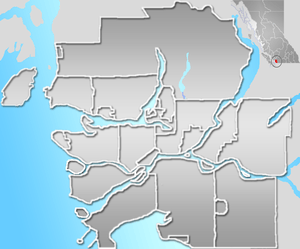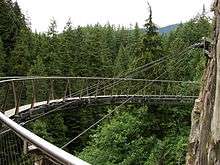Capilano Suspension Bridge
| Capilano Suspension Bridge | |
|---|---|
 The Capilano Suspension Bridge | |
| Coordinates | 49°20′34″N 123°06′44″W / 49.34278°N 123.11222°WCoordinates: 49°20′34″N 123°06′44″W / 49.34278°N 123.11222°W |
| Carries | Pedestrians |
| Crosses | Capilano River |
| Locale | North Vancouver (district), British Columbia |
| Characteristics | |
| Design | Simple Suspension |
| Total length | 140 metres (460 ft)[1] |
| Height | 70 metres (230 ft) |
| History | |
| Opened | 1889 |
| Statistics | |
| Daily traffic | Around 2,200 per day (800,000 per year) |
 Location of Capilano Suspension Bridge in Metro Vancouver  | |
The Capilano Suspension Bridge is a simple suspension bridge crossing the Capilano River in the District of North Vancouver, British Columbia, Canada. The current bridge is 140 metres (460 ft)[1] long and 70 metres (230 ft) above the river. It is part of a private facility with an admission fee, and draws over 800,000 visitors a year.
History
The bridge was originally built in 1889 by George Grant Mackay, a Scottish civil engineer and park commissioner for Vancouver. It was originally made of hemp ropes with a deck of cedar planks, and was replaced with a wire cable bridge in 1903. In 1910 Edward Mahon purchased the Capilano Suspension Bridge. "Mac" MacEachran purchased the Bridge from Mahon in 1935 and invited local natives to place their totem poles in the park, adding a native theme. In 1945, he sold the bridge to Henri Aubeneau.
The bridge was completely rebuilt in 1956.[2]
The park was sold to Nancy Stibbard, the current owner, in 1983. Annual attendance has since increased, and in May 2004, Treetops Adventures was opened. This new attraction consists of seven footbridges suspended between old-growth Douglas Fir trees on the west side of the canyon, forming a walkway up to 30 metres (98 ft) above the forest floor.
Other park features

As well as the bridge and Treetops Adventure, the first venue of its kind in North America, the park also features rain forest ecotours, award-winning gardens, nature trails, North America's largest private collection of First Nations totem poles, period decor and costumes, and exhibits highlighting the park's history and the surrounding temperate rain forest. Guests can also witness a First Nations performance, featuring their traditional Regalia (ceremonial dress), masks, dancing and storytelling.
In June 2011, a new attraction called Cliff Walk was added to the park. This adventure is included with the entrance fee.
Incidents
In 1999, a woman dropped her 18-months-old, disabled child off the bridge. She claimed she stumbled accidentally and the child slipped from her grasp. The child was not seriously injured.[3] The woman lost legal custody of her child as a result of the incident. The woman took legal action against the owner of the bridge, alleging negligence by the owner. The case was settled out of court.
In 2006, a 300-year-old, 46-tonne Douglas fir tree toppled during a heavy snowstorm.[4] The tree fell across the western end of the bridge. Park officials closed the bridge temporarily while repairs were performed.
On June 6, 2010, a teenage tourist on a class trip from California climbed over a railing and fell more than 30 metres (98 ft) from a fenced off viewing platform near the bridge. By the time rescue workers came to his aid, the victim was dead.[5] The official RCMP finding was that the teen was under the influence of LSD at the time of the incident.[6]
On June 2, 2012 a 30-year-old tourist from Ontario died after falling near the bridge. Police say the victim was hiking through trails near the popular attraction when he climbed over a railing and fell to the riverbed below.[7]
Popular culture
The bridge has been featured as a setting in episodes of several television series, including MacGyver, Sliders, The Crow: Stairway to Heaven, and Psych.
In 1974, social psychologists Donald Dutton and Arthur Aron conducted a well-known experiment on the bridge. Men approached by a female researcher on the bridge were more likely to call her later than men approached on a more solid bridge across the river. Dutton and Aron argued that this supported the theory that the men were mis-attributing the arousal caused by fear to sexual attraction toward the woman.[8] This research supported Stanley Schachter's two-factor theory of emotion.
See also
References
- 1 2 Capilano Suspension Bridge (1903) at Structurae
- ↑ n-link (2008). ASCE, ed. Bridges 2009. Reston, Virginia, USA: American Society of Civil Engineers. p. August 2009 featured bridge. ISBN 978-0-7844-1001-1. Retrieved 2009-08-03.
- ↑ "RCMP suspect mother threw baby off bridge". CBCNews Canada. 2000-11-10. Retrieved 2014-06-13.
- ↑ Habdank, Joanna; Weldon, James (2006-12-01). "More snow adds to woes and record". North Shore News.
- ↑ "Teen dies after fall at Capilano suspension bridge - The Globe and Mail". The Globe and Mail. Toronto. June 7, 2010.
- ↑ "LSD ruled a factor in Capilano bridge death". CBC News. October 24, 2010.
- ↑ "Ontario hiker dies in fall at B.C.'s Capilano bridge". CBC News. June 3, 2012.
- ↑ Dutton, Donald G.; Aron, Arthur P. (October 1974). "Some evidence for heightened sexual attraction under conditions of high anxiety". Journal of Personality and Social Psychology. 30 (4): 510–517. doi:10.1037/h0037031. PMID 4455773.
- North Shore News September 27, 1999
- Gut Rumbles August 26, 2004
- Woman who dropped baby on bridge ends lawsuit - By: N.A.. Record, The (Kitchener/Cambridge/Waterloo, ON), 11/03/2004; (AN Q4K036229702804)
External links
| Wikimedia Commons has media related to Capilano Suspension Bridge. |
- Official Capilano Suspension Bridge and Park website
- Capilano Suspension Bridge (1889) at Structurae
- Capilano Suspension Bridge (1903) at Structurae
